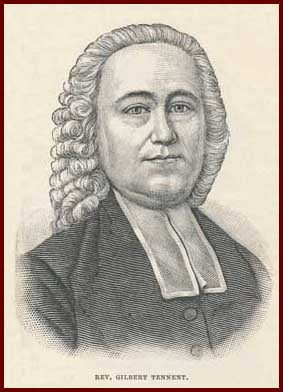This Day in Presbyterian History:
A Pure Ministry was His Concern
 Born in what is today Northern Ireland, or Ulster, in 1703, Gilbert Tennent, the oldest son of William Tennent, was the first of five sons of the Tennent family to train for, and minister in, the Presbyterian Church in America. Emigrating to the colonies in 1717 to Pennsylvania, he studied under his father William, the elements of Scriptural languages and theology. His training must have been the equivalent of a bachelor of arts degree, because when he entered Yale College, he completed a masters of arts degree. He then helped his father build the Log College, as it was derisively known, which was the forerunner of the College of New Jersey, which turned into Princeton Seminary and University.
Born in what is today Northern Ireland, or Ulster, in 1703, Gilbert Tennent, the oldest son of William Tennent, was the first of five sons of the Tennent family to train for, and minister in, the Presbyterian Church in America. Emigrating to the colonies in 1717 to Pennsylvania, he studied under his father William, the elements of Scriptural languages and theology. His training must have been the equivalent of a bachelor of arts degree, because when he entered Yale College, he completed a masters of arts degree. He then helped his father build the Log College, as it was derisively known, which was the forerunner of the College of New Jersey, which turned into Princeton Seminary and University.
Licensed and ordained in the Presbyterian church, Gilbert Tennent, after a brief ministry in Newcastle, Delaware, moved in 1726 to New Brunswick Presbyterian Church, in New Jersey. It was there that he came into contact with a Dutch Reformed pastor, Theodorus Frelinghausen, who regularly preached revivalist messages to his congregation and surrounding congregations. Tennent, whose ministry up to this point, was failing as far as converts were concerned, and deathly ill on top of it, made a pact with God. Promising to press for the souls of his people, he asked God to give him another six months of life. God gave him that, and more. He began to preach evangelistically to his own people.
Heard one day by English evangelist George Whitefield, who described his sermon as “a searching sermon,” Tennent immediately began to feel the effects of criticism to his ministry as well as the educational quality of the teaching at his father’s Log College. It was then in March 8, 1740 that he preached that stern message entitled “The Dangers of an Unconverted Ministry,” comparing those who opposed the revival methods to Pharisees who were unsaved. (See March 8) One year later, the first schism occurred in the Presbyterian Church between the Old Side Presbyterians and the New Side Presbyterians. (See May 27, 1741) This schism was to last until 1758, when the reunion came with the aid of a now repentant Gilbert Tennent. (See May 25)
Gilbert Tennent’s third congregation was at the Second Presbyterian Church in Philadelphia, in 1743. This congregation was a New Side Presbyterian congregation, formed exclusively of converts to the Whitefield’s strong preaching. He pastored that church until his death on July 22, 1764.
Gilbert Tennent had a decided care and concern for the purity of Christ’s church.
Words to Live By: Despite an unwise harsh message at an earlier point in his ministry which brought a schism in the church at large, his later ministry at Second Presbyterian Church in Philadelphia was in the midst of a turn-around, or repentant spirit in him. We may not want to copy his methods to bring revival to God’s people and repentance to the lost, but the purity of Christ’s church is still an important care and concern for all ministers and members of His church.
Through the Scriptures: Isaiah 46 – 48
Through the Standards: The sins of inferiors against superiors
WLC 128 — “What are the sins of inferiors against their superiors?
A. The sins of inferiors against their superiors are, all neglect of the duties required toward them; envying at, contempt of, and rebellion against, their persons, and places, in their lawful counsels, commands, and corrections; cursing, mocking, and all such refractory and scandalous carriage, as proves a shame and dishonor to them and their government.”

